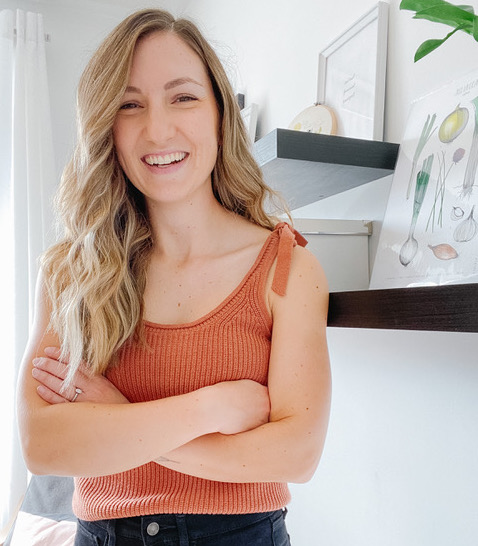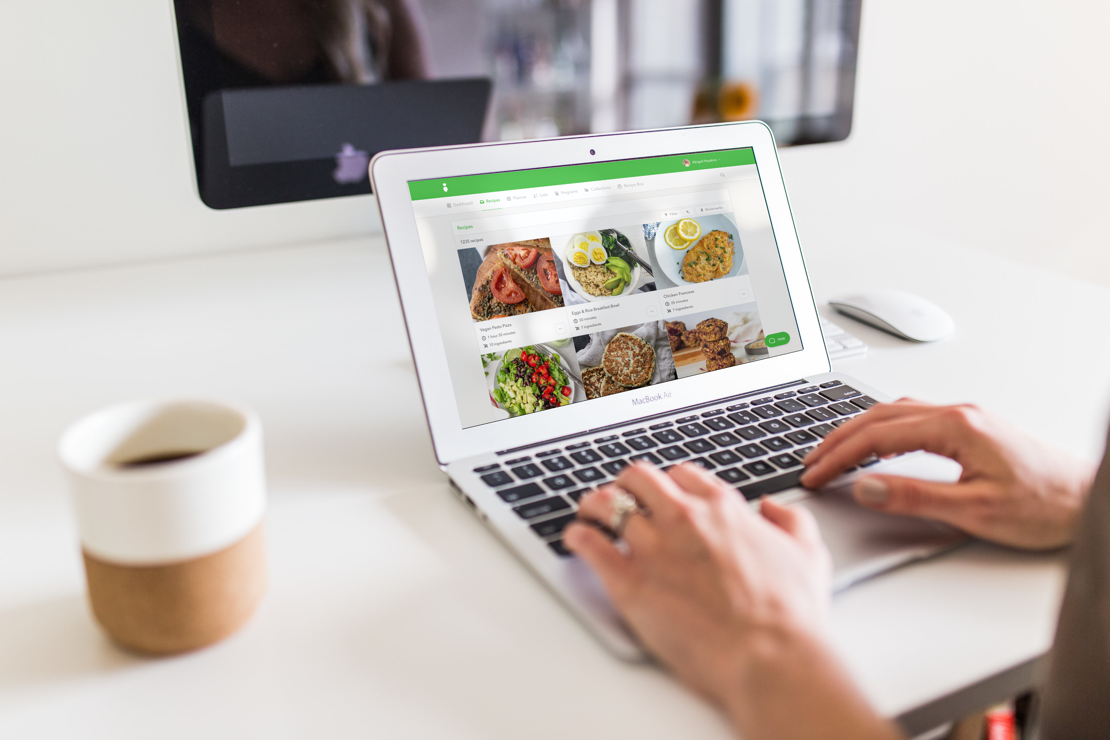Have you been thinking about creating an online course for your nutrition business but you don't know where to start? If you want to learn the start to finish process of online course creation, this article is for you.
We talked to Registered Dietitian and nutrition course expert Krista Kolodziejzyk for a step-by-step guide on how to plan, create, test, launch, and market your first or next online nutrition course.
Krista is the founder of Dietitian Success Center, an online learning platform designed to make it easier for dietitians and dietetic students to build their confidence and expertise in both nutrition and entrepreneurship. One of her specialty areas is guiding nutrition professionals through an Online Course Blueprint to create a course that sells.

An online course is a series of lessons on a particular specialized topic. As a health professional, you can take the information you would typically teach to a client in a one-on-one setting, record it, and upload it to an online course platform to automate it into something you can continue to sell over and over again.
You can sell an online nutrition course as a stand-alone offer or give it to your clients as supplementary material to learn. When used as supplementary material, the course automates the education piece and can help your clients focus on action planning and strategizing during a nutrition consult or in a group program.
Why Every Nutrition Business Needs An Online Course
Krista believes that having an online course is a must for every nutrition professional and business. Here are the three big reasons why:
- Diversify your income streams. Doing one-on-one consults is often not scalable as you reach a limit of the number of clients and consults you can manage. Whereas, with an online course, you create it once and can sell it exponentially. This opportunity to bring in income that doesn't require one-on-one work diversifies your business's revenue streams.
- It reduces practitioner burnout. Teaching the same material over and over again can lead to feeling burnt out. When you create an online course, you take the content from your consults and automate this education piece which saves energy and time. Nutrition professionals are in the perfect position to create online courses because the content doesn't always require in-person consults and can easily be taught in online lessons.
- You can use the course to get more clients. Anytime someone can learn from you and build trust, they are going to stick around for longer and are more likely to become a client. It's likely that a client who has gained valuable knowledge from your standalone course will be a repeat client for other services you offer.
Choosing the Right Time to Create An Online Course
Krista says if you know enough to work one-on-one with a client, then you are ready to create an online course.
"Because essentially, we're taking what we teach to a client and we're packaging it into a course, something that is automated and that doesn't require you to actually be present to teach your material."
Krista recommends working one-on-one with clients first to understand the knowledge level your ideal clients are at, the challenges they experience, and to assess for consistent themes and topics that your clients are interested in learning about.
Course Topic & Content
Your course topic should be focused on a specific group and provide a solution to a nutrition challenge they are dealing with.
Once you decide on a topic, it's time to divide out the content. Krista's strategy is to brainstorm what you would teach to a client in a series of one-on-one nutrition sessions. For example, for clients with PCOS, you may teach them about the background of PCOS, symptoms, nutrition implications and interventions, supplements, meal planning, etc. Then, take the content and sort it into modules. Within each module, you create lessons. A module can be around 30 to 60 minutes and each lesson should be five to 10 minutes.
"Divide the teaching into small manageable chunks so it’s easy to digest. When it comes to online education, shorter and sweeter is always better.”
That Clean Life is a great tool when it comes to creating course content. You can create meal plans, recipe collections, and guides to go along with your modules and lessons.

Course Length
The length of your course will depend on what you’re teaching, what you want to achieve with the course, and the transformation end goal for the customer.
Krista suggests starting with a medium to large course as most clients are starting with minimal knowledge and want to learn everything about your niche topic.
"The great thing about a large course is that we can charge more for it. We’re putting all this time and effort into course creation and creating this amazing tool and resource, that you can charge a higher price for it and your odds of customer success are higher when they are well equipped and you’re teaching them everything that they need to know."
Platforms & Technology
Krista has found that the biggest misconception is practitioners need to invest in a lot of technology and be tech-savvy.
"There are just three pieces: material creation, recording, and then publishing the course content. It can be as simple as a screen recording or Zoom recording where you teach content on a slide deck like Powerpoint or Canva. Once you are done recording, you have an mp4 file which can be uploaded to a course platform."
You will need a few essentials:
- Good audio. Make sure you have a good microphone and you record in a room with minimal echo.
- An online course platform to host your course such as Teachable, Thinkific, or Kajabi.
- Nutrition planning software like That Clean Life to help you create nutrition resources to go along with your lessons.
"Start with Teachable where you can upload your mp4 files as videos, you sort these into modules, and the platform even offers a sales page so your clients can purchase through the platform as well. Don't get hung up on analysis paralysis - the most important thing is getting the content out there, educating, and helping people."
Pricing & Beta Testing
As a starting point, do an environmental scan of what courses are out there. If they are offering something similar, it will be a good indication of what clients might be willing to pay. However, Krista still says don't purely go off what other people are doing, you also need to price your course based on your client's transformation, that is how valuable your material is to help get your client from point A to B in their learning journey.
Krista recommends beta testing the course first at a reduced price to work smarter, not harder:
"Don't get to the point where you have invested several hours creating the course and it doesn’t sell. Mitigate the fear and risk by doing a beta test."
- Map out the course of what you're going to cover.
- Create the first module and sell it as a beta to a handful of people at a reduced price. Use your email list and social media following to beta test the course as they already know you as the subject matter expert and have started to develop trust.
- Then create and release modules after that so people in the beta know that they're getting more modules weekly after that. This will help validate your idea and keep you accountable to create course content.
It's important to get feedback during your beta test and you can do this by sending a survey when the client is at halfway mark and then again at the end of the course.
"As experts in the area, we might be missing topics or not communicating the information clearly enough, and we only know this if we ask. This helps create a course that your clients actually need and that's well priced."
Market & Sell Your Online Nutrition Course
The biggest part of getting your course out there is selling and marketing it.
"Start building your audience on day one through social media and your email list, so that when your course is ready, you have people that are excited to buy it. This helps to ensure that when you are ready to sell your course, you have people ready to purchase it."
To help sell your course, give your potential clients a sneak peek of what to expect by hosting a free webinar related to your course so it provides a feel for what they're going to get in the course and they're much more likely to purchase after that experience. To build your email list, you can use a lead magnet. This gets people thinking about what the next steps are and the course is the natural progression from there.
"Clients need to visualize what they're going to get and how it's going to be valuable. When creating a free download like a lead magnet, it should feel like you are giving away gold for free. If you feel like it's pretty basic, then the person downloading it will feel like it's basic and not valuable. It's the power in having something really great."
Key Lessons
- If you have worked with clients, you can create a course.
- You don’t need to be tech-savvy to create a course. Just keep it simple.
- Don’t get hung up on analysis paralysis. Keep moving forward and it doesn’t need to be perfect the first time.
- Audience building is crucial and you have to make sure you are incorporating the sales and marketing piece from day one.


